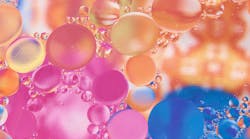This article was originally published Aug. 1, 2000. It was updated Jan. 25, 2023.
RELATED
Lubricating Plastic Gears and Bearings
Tribology by Design: A Revolution in Tribology
Lubricants for Electric Cars and Trucks
Why Maintenance of Water Glycol Hydraulic Fluids Makes All the Difference
Lubricants not only reduce friction and wear in large and small machines, they also prevent corrosion. But all of these advantages are put at risk if the lubricants are contaminated by water. Water in a lubricant makes it less slippery and less able to lubricate, which leads to corrosion. It also degrades the lubricant’s low-temperature performance.
Exactly how a lubricant performs in the presence of water depends on three factors: the amount of water, its corrosive nature (is it salty or alkali?) and whether it will it be used in a static dynamic application.
However, if the amount of water reaches as little as 5%, it can reduce the lubricant’s adhesion and load-carrying capability, leading to increased wear.
Even equipment not operating in a wet environment is prone to water contamination of its lubricants. After equipment is shut down at the end of the day, for example, it cools down and condensation from the air gets pulled into the bearings and other lubricated components.
How much water a lubricant will absorb depends on its formulation (i.e., what it is made of), lubricant type and how much mechanical action it will experience. Most oils have little resistance to water absorption. That’s why greases, which have much more water resistance, are usually applied if the application will be routinely exposed to water. Unfortunately, greases do tend to lose adhesion—i.e., their ability to “stick” where they are applied, often a characteristic for which they are chosen. As the grease absorbs more and more water, it softens, loses adhesion and washes away.
It takes mechanical action to coax water into most lubricating oils (mineral, PAO, silicone, PFAE) and form a water/oil emulsion. But certain “thirsty” oils (hydrophilic polyglycols and some ester types) readily absorb water even without mechanical action.
To ensure water doesn’t ruin lubricant performance, many machine operators opt for water-resistant versions. Water-resistant greases are good choice for applications exposed to water and where currently used greases are being washed away. Water-resistant greases include lithium complex, calcium complex and barium complex, plus polyurea and clay-based versions.
Although water-contamination is often cited for lubricants with reduced load capacities and lubricants getting washed away, corrosion on gears and bearings is a larger, more serious problem. One solution is to use a lubricant that readily absorbs water. This might seem counterintuitive, but such greases prevent free water from contacting the bearing and gears and thus prevent corrosion.
How much water a grease can absorb is a function of what thickener is included on it formulation. For example, some lithium soap greases can absorb up to 100% of their weight in water. Barium and calcium-thickened greases absorb up to 40%. And polyurea greases absorb as little as 20%. Clay greases have good water resistance, as mentioned earlier, but their contribution to corrosion resistance is poor.
Greases, unlike oils, can absorb or resist water, making them a double-edged sword of sorts. If a grease does not absorb enough water, that water goes on to corrode gears and bearings. But if it absorbs too much water, it degrades—possibly washing away, and no longer preforms its main function. So designers and machine operators must strike a balance when choosing just the right grease for their applications. They need one that absorbs enough to prevent corrosion but not enough to overly degrade the grease.
Good choices of lubricants for meeting this balancing act are calcium complex, barium complex and polyurea-thickened greases. To ensure this what is being used, check the grease container’s label. For tamping down condensation concerns (and they are the only concerns), lithium complex is best suited to the challenge.
The best way to protect bearing and seals against corrosion is to seal bearings and gearboxes. But even with the best contact seals, water may get in. Maintenance technicians should therefore frequently inspect the lubricant and equipment, replacing grease if it looks runny, or oil if it looks milky white.
If water contamination is unavoidable, many companies resort to using chrome-plated parts for corrosion protection, along with water-resistant grease to get the best lubrication. Others use a dual approach, applying water-resistant lubricant to the seals to keep water out of bearing and gearbox, and using a water-absorbing lubricant on the bearings and gears to stop corrosion.
Richard Gianattasio was a technical engineer, Kluber Lubrication North America Inc., Londonderry, N.H., when this first appeared.
